Hey there, fellow music lover! Remember the first time you dropped the needle on a vinyl record and heard that warm, rich sound fill the room?
It’s a magical experience, right? Well, what if I told you that you could combine that vintage charm with the convenience of modern wireless speakers?
That’s right – we’re talking about connecting your turntable to Sonos!
I’ve been tinkering with audio setups for years, and let me tell you, figuring out how to marry my old-school turntable with my shiny new Sonos system was a game-changer.
Sure, I made a few mistakes along the way (like that time I forgot about the preamp and wondered why everything sounded like a whisper), but now I’ve got it down to a science.
So, grab your favorite record, and let’s dive into the world of vinyl-meets-wireless!
How to Connect a Turntable to Sonos
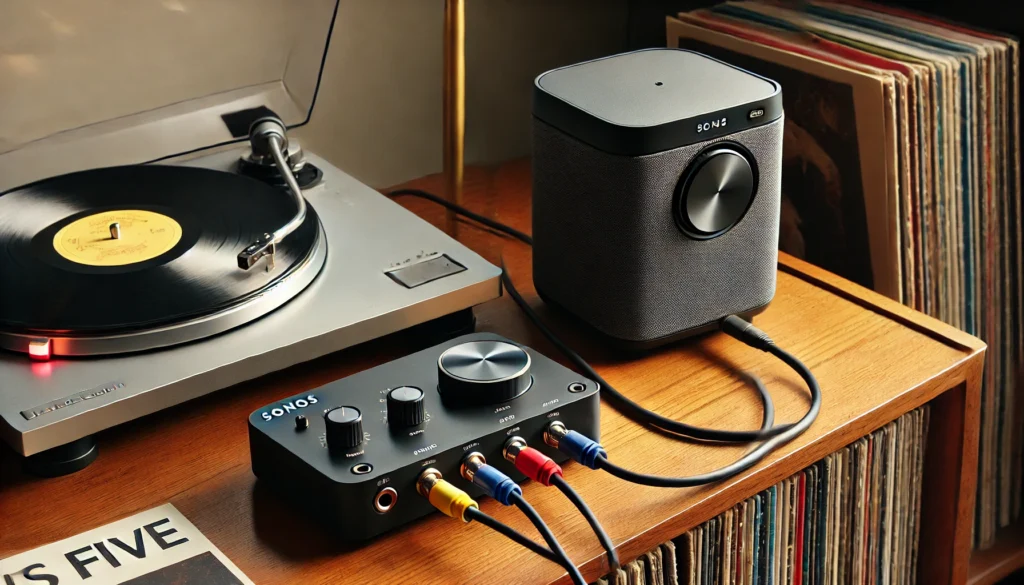
Connecting a turntable to Sonos is a process that involves using a phono preamp and a Sonos device with a line-in port, such as the Sonos Five or Sonos Port.
You’ll need to connect your turntable to the phono preamp, then connect the preamp to your Sonos device using RCA cables.
After making the physical connections, you’ll need to configure the Sonos app to recognize the turntable input.
This setup allows you to stream your vinyl collection through your Sonos speakers, combining the warmth of analog sound with the convenience of wireless audio.
We’ll explore this process in more detail below, but that’s the gist of how to connect your turntable to Sonos!
Understanding Turntables and Sonos Compatibility
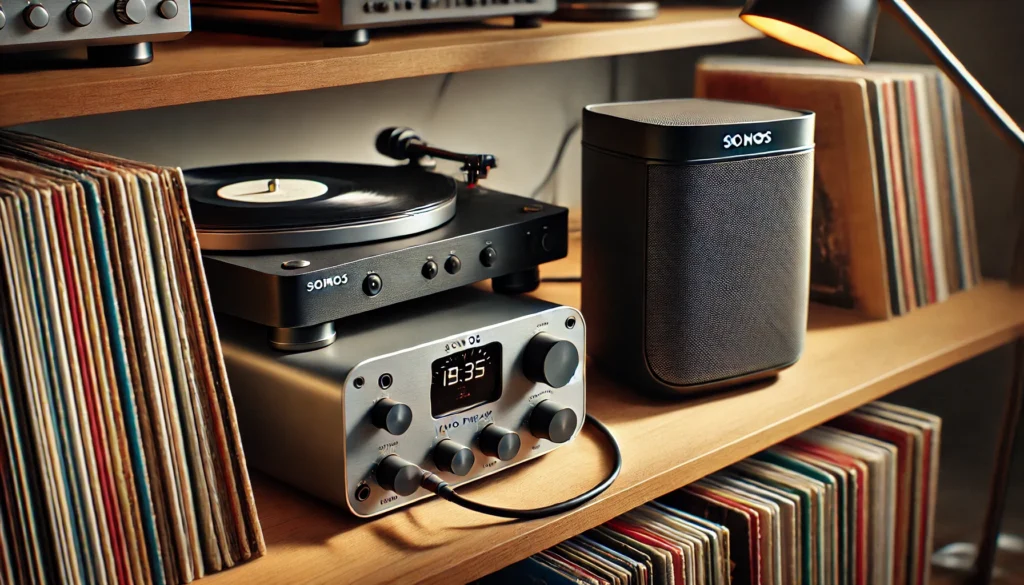
Alright, let’s get down to brass tacks. When I first decided to connect my trusty turntable to my Sonos system, I was like a kid in a candy store – excited but totally overwhelmed.
I mean, we’re talking about bridging the gap between technology from different eras here!
First things first, you need to understand that turntables output a very low-level signal that needs to be amplified before it can play nice with other audio equipment.
This is where a phono preamp comes in. Some turntables have this built-in (aren’t they fancy?), but most don’t.
I learned this the hard way when I first plugged my turntable directly into my Sonos and heard… well, practically nothing.
Now, on the Sonos side of things, you’re going to need a Sonos device with a line-in port.
The main contenders here are the Sonos Five (formerly Play:5), Sonos Port, or Sonos Amp. These bad boys are designed to accept external audio sources, which is exactly what we need for our vinyl setup.
I remember when I first got my Sonos Five, I was so excited to start playing my records through it.
But here’s a pro tip: make sure your Sonos device is placed somewhere accessible. I initially had mine tucked away on a high shelf, which made connecting cables a real pain in the neck – literally!
One more thing to keep in mind is that once your turntable is connected to Sonos, you can stream that sweet, sweet vinyl sound to any Sonos speaker in your home.
It’s like magic, I tell you! I nearly fell off my chair the first time I heard my favorite jazz record playing in perfect sync throughout my house.
Remember, compatibility is key here. Not all turntables are created equal, and neither are all Sonos devices.
But don’t worry, we’ll get into the nitty-gritty of what equipment you’ll need in the next section. Trust me, once you get this setup right, you’ll be in audio heaven!
Essential Equipment for Connecting a Turntable to Sonos
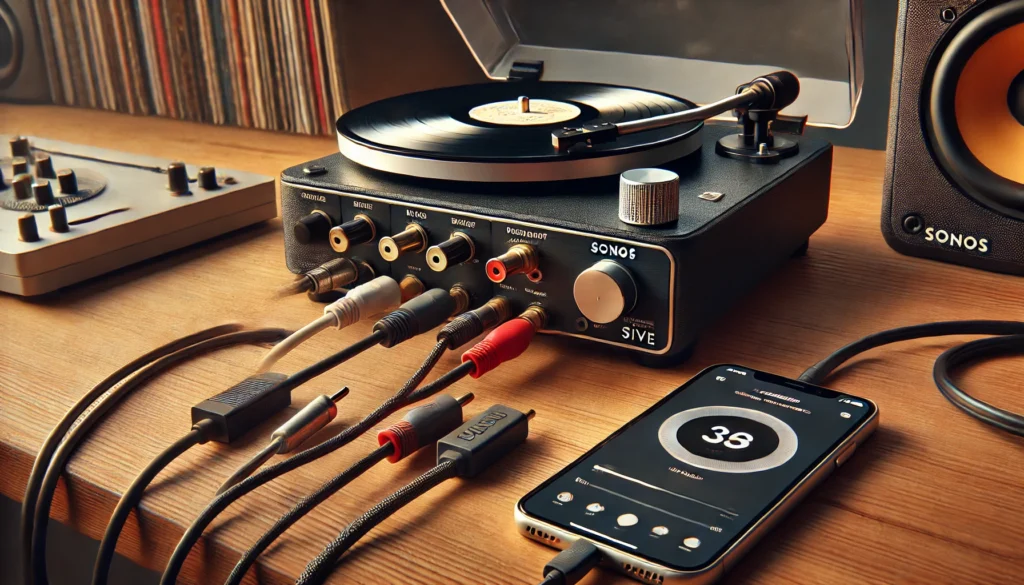
Okay, folks, it’s time to talk gear! When I first decided to connect my turntable to Sonos, I felt like I was prepping for a mission.
I mean, I had a list longer than my arm! But don’t worry, I’ve simplified it for you based on my own trial and error.
First up, obviously, you need a turntable. Duh, right?
But here’s the kicker – make sure it has a built-in preamp, or be prepared to buy one separately. I learned this the hard way when I first tried to connect my vintage turntable directly to my Sonos.
Let’s just say it was quieter than a mouse in a library!
Next, you’ll need a Sonos device with a line-in port. Your best bets are the Sonos Five, Sonos Port, or Sonos Amp.
I personally use a Sonos Five, and let me tell you, it’s been a game-changer. Just make sure you place it somewhere easily accessible – I initially had mine on a high shelf and nearly gave myself a hernia trying to connect everything!
Now, let’s talk cables. You’ll need a set of RCA cables to connect your turntable (or preamp) to your Sonos device.
Pro tip: don’t skimp on the cables! I once bought the cheapest ones I could find, and the sound quality was about as good as two tin cans connected by string.
If your turntable doesn’t have a built-in preamp, you’ll need a separate phono preamp. This little box of magic boosts the signal from your turntable to a level that your Sonos can understand.
Trust me, it’s worth the investment!
Oh, and don’t forget about the grounding wire! Some turntables come with this, and it’s crucial for reducing unwanted hum.
The first time I hooked everything up without it, my system sounded like a swarm of angry bees!
Lastly, you’ll need the Sonos app on your smartphone or tablet. This is where you’ll configure everything and control your music.
It’s pretty user-friendly, but I’ll admit I spent a good hour poking around and accidentally blasting music at 2 AM. Sorry, neighbors!
Remember, quality matters. I tried to cut corners at first, and let’s just say the result was less than stellar.
Invest in good equipment, and your ears will thank you. Trust me, when you hear that first needle drop through your Sonos speakers, it’ll all be worth it!
Step-by-Step Guide to Connecting Your Turntable
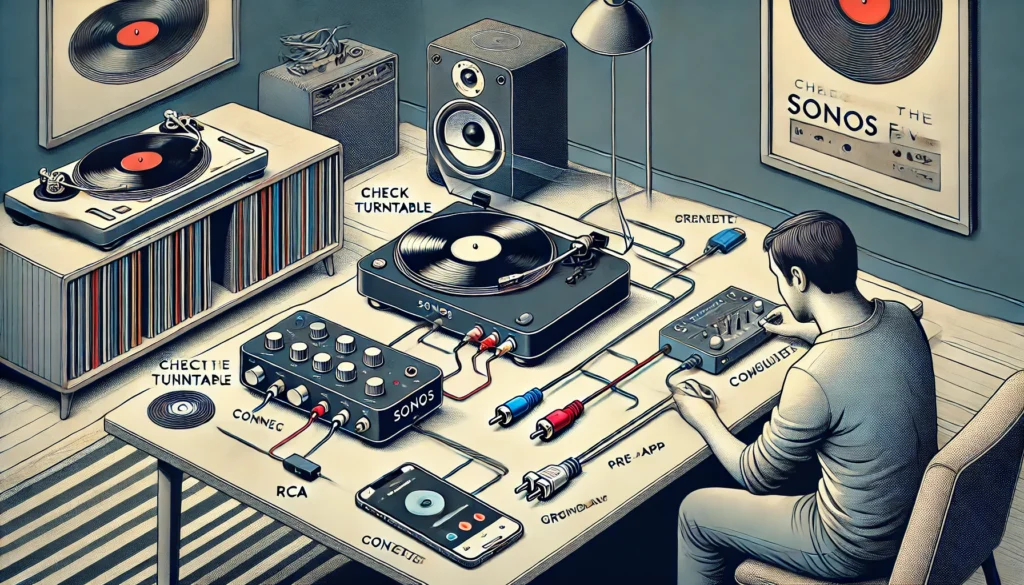
Alright, music lovers, it’s time to roll up our sleeves and get down to business! Connecting your turntable to Sonos might seem like rocket science at first, but trust me, if I can do it, anyone can.
So, let’s break it down step by step.
Step 1: Check your turntable
First things first, figure out if your turntable has a built-in preamp. If it does, great!
If not, don’t panic – we’ll just need to add an external one to the mix. I remember when I first realized my vintage turntable didn’t have a preamp.
I was all, “Preamp? What’s that?” Oh, how far we’ve come!
Step 2: Connect the preamp (if necessary)
If you need an external preamp, connect your turntable to it using RCA cables. Make sure to match the colors – red to red, white to white.
It’s not rocket science, but I’ll admit I got them mixed up once. Let’s just say the sound was… interesting.
Step 3: Connect to Sonos
Now, connect your turntable (or preamp) to your Sonos device. I use a Sonos Five, but a Port or Amp works too.
Again, use those RCA cables and match the colors. This is where I nearly took out my entire audio setup trying to reach behind my poorly placed Sonos.
Learn from my mistakes, folks – accessibility is key!
Step 4: Grounding
If your turntable has a grounding wire, connect it to the grounding terminal on your preamp or Sonos Amp. Skipping this step?
Prepare for a hum that’ll drive you nuts. Been there, done that, got the t-shirt!
Step 5: Power up
Plug in and turn on all your devices. This is the moment of truth!
I remember holding my breath the first time I did this, half expecting something to explode. Spoiler alert: it didn’t.
Step 6: Configure the Sonos app
Open your Sonos app and add the line-in source. Go to Settings > System > [Your Sonos Device] > Line-In.
Select the appropriate source name (like “Turntable”) and adjust the line-in level. This part took me a while to figure out, but once I did, it was smooth sailing.
Step 7: Play that funky music!
Put on a record, drop the needle, and bask in the glory of vinyl through your Sonos speakers. The first time I heard it, I danced around my living room like a lunatic.
No regrets!
Remember, patience is key here. It might take some tweaking to get everything just right, but don’t get discouraged.
And for heaven’s sake, don’t be like me and attempt this after a few beers. Turns out, audio setup and alcohol don’t mix well.
Who knew?
Optimizing Your Turntable-Sonos Setup for Best Sound Quality
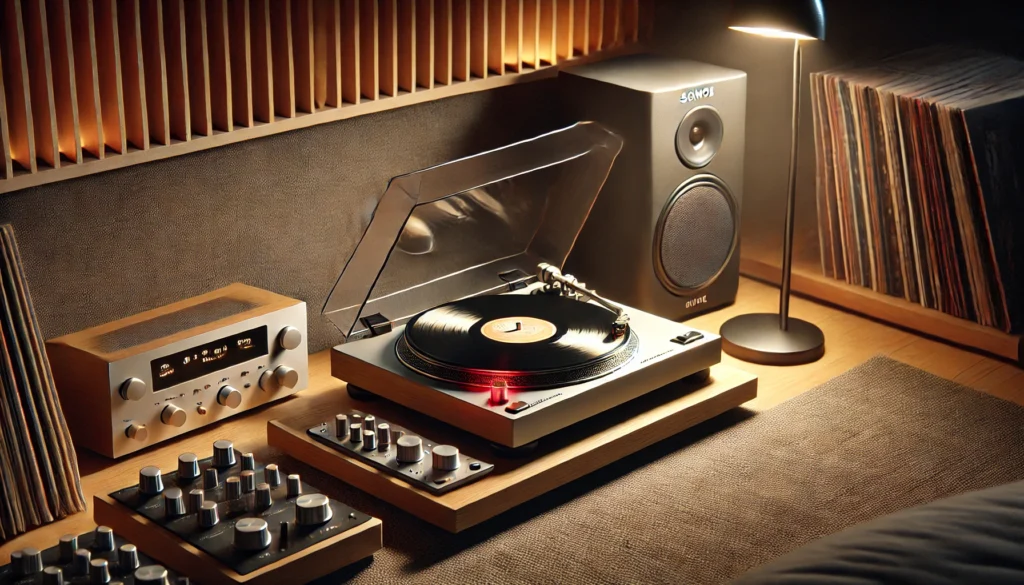
Alright, audiophiles, now that we’ve got everything connected, it’s time to fine-tune our setup. Because let’s face it, we didn’t go through all this trouble just to settle for mediocre sound, did we?
Nope, we’re after audio nirvana here!
First things first, let’s talk about turntable placement. I learned this the hard way when I first set up my system right next to my refrigerator.
Every time the fridge kicked on, my records sounded like they were playing underwater! Keep your turntable away from vibrations and electrical interference.
A solid, level surface is your best bet.
Next up, cartridge alignment. This is where things get a bit techy, but stick with me.
Your cartridge needs to be properly aligned to get the best sound and avoid wear on your precious vinyl. I remember spending hours with a protractor, squinting at my cartridge like it held the secrets of the universe.
It was worth it though – the improvement in sound quality was night and day!
Now, let’s talk about tracking force and anti-skate. These settings ensure your needle sits just right in the groove of your records.
Too much pressure, and you’ll wear out your vinyl faster than you can say “audiophile.” Too little, and you’ll be skating across the surface like a clumsy ice skater.
Trust me, finding that sweet spot is crucial.
On the Sonos side of things, don’t forget to play around with the settings in the app. The line-in level is particularly important.
Set it too high, and you’ll get distortion. Too low, and you’ll be straining to hear anything.
I spent a good week tweaking this until I found the perfect balance.
Room acoustics matter too! I once had my speakers set up in the corner of my room, and let me tell you, the bass was so boomy it felt like I was inside a subwoofer.
Experiment with speaker placement and consider acoustic treatments if you’re really serious about sound quality.
Don’t forget about your vinyl care routine. Clean records sound better, period.
I learned this after playing a particularly dusty album and wondering why it sounded like it was recorded in a sandstorm.
Lastly, be patient and trust your ears. What sounds good to me might not be perfect for you.
I spent countless hours fine-tuning my setup, and honestly, I’m still tweaking it. It’s a labor of love, but when you drop that needle and hear your favorite album in all its glory through your Sonos speakers, it’s all worth it.
Remember, optimizing your setup is a journey, not a destination. Embrace the process, and before you know it, you’ll be the go-to person for all your friends’ audio questions.
Just don’t be surprised if they start calling you “The Vinyl Whisperer.” Yes, that’s a thing now.
I should know – it’s what my neighbors call me!
Troubleshooting Common Issues When Connecting Turntables to Sonos
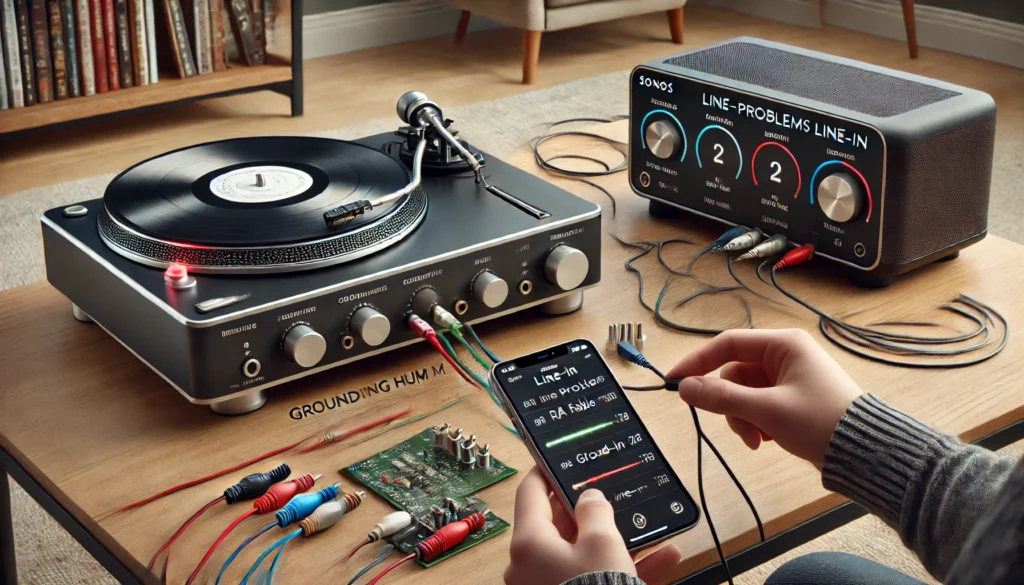
Alright, folks, let’s talk troubleshooting. Because let’s face it, even with the best instructions (ahem), things can sometimes go a bit sideways.
Don’t worry, though – I’ve been there, done that, and got the “I Survived Turntable-Sonos Integration” t-shirt to prove it!
First up, the dreaded hum. If you’re hearing a constant buzz that’s louder than your Great Aunt Mildred after her third glass of wine, you might have a grounding issue.
I remember the first time I heard this – I thought a bee had somehow gotten into my speaker! Make sure your turntable is properly grounded.
If you’re using an external preamp, double-check that the ground wire is connected.
No sound at all? Been there! First, check all your connections.
I once spent an hour troubleshooting only to realize I hadn’t pushed the RCA cables in all the way. Talk about a facepalm moment!
Also, make sure you’ve selected the correct input source in the Sonos app. It’s an easy thing to overlook, trust me.
If your sound is distorted or too quiet, you might need to adjust the line-in level in the Sonos app. I remember playing a record for the first time through my setup and it sounded like it was being played through a tin can telephone.
A few tweaks to the line-in level, and voila – audio bliss!
Skipping or skating issues? This could be due to improper cartridge alignment or incorrect tracking force.
I once had a record that kept skipping at the same spot. Turns out, my tracking force was way off.
A little adjustment, and suddenly my needle was riding those grooves like a champ!
If you’re hearing a lot of surface noise or static, it might be time to clean your records and stylus. I learned this lesson after pulling out some old records from my college days.
Let’s just say they were carrying more dust than a neglected attic!
One issue that had me scratching my head for days was intermittent sound cutting out. Turns out, it was a Wi-Fi issue.
Make sure your Sonos device has a strong connection to your network. I ended up moving my router, and suddenly, smooth sailing!
Lastly, if you’re not getting that warm, full sound you expect from vinyl, you might need to play around with your Sonos EQ settings.
I spent a good week tweaking these until I found the perfect balance. It was like finding the audio equivalent of the Holy Grail!
Remember, troubleshooting is part of the fun… okay, maybe “fun” is stretching it, but it’s definitely part of the process.
Don’t get discouraged if things aren’t perfect right away. Keep at it, and before you know it, you’ll be enjoying your vinyl collection through your Sonos speakers without a hitch.
And hey, if all else fails, there’s always the trusty “turn it off and on again” method. You’d be surprised how often that works.
It’s like magic, I tell you!
Conclusion
Whew! What a journey we’ve been on, huh? From understanding the basics of turntables and Sonos compatibility to troubleshooting those pesky issues, we’ve covered it all.
And let me tell you, connecting my turntable to Sonos has been one of the best audio decisions I’ve ever made!
Remember when we started? The idea of marrying old-school vinyl with modern wireless speakers seemed like a dream.
But now, here we are, spinning records and enjoying that warm, rich sound through our Sonos system. It’s like having the best of both worlds!
I won’t lie – there were moments when I thought about throwing in the towel. Like that time I couldn’t figure out why my system was humming louder than a beehive.
Or when I accidentally blasted my neighbors with a 2 AM jazz session (sorry again, Mrs. Johnson!). But trust me, the payoff is worth every bit of frustration.
The beauty of this setup is how it brings together the tactile, intimate experience of vinyl with the convenience of modern technology.
There’s something special about carefully selecting a record, gently lowering the needle, and then being able to hear that music anywhere in your home. It’s like magic, I tell you!
But here’s the thing – your journey doesn’t end here. The world of audio is vast and ever-evolving.
Don’t be afraid to experiment, to tweak, to try new things. Maybe you’ll upgrade your cartridge, or try out different Sonos speakers.
The possibilities are endless!
And remember, this isn’t just about the tech – it’s about the music. It’s about rediscovering your favorite albums, or introducing your kids to the joys of vinyl.
It’s about hosting listening parties where your friends marvel at how you’ve managed to combine retro cool with modern convenience.
So go ahead, drop that needle, fire up your Sonos, and let the music play. And if you run into any hiccups along the way, just remember – we’ve all been there.
Keep at it, and before you know it, you’ll be grooving to your vinyl collection in every room of your house.
Now, if you’ll excuse me, I’ve got a date with my turntable and a stack of records that aren’t going to play themselves.
Happy listening, folks!
Oh, and one last thing – don’t forget to share your own experiences in the comments below. Did you run into any unique challenges?
Any tips or tricks you’ve discovered? Let’s keep this vinyl-meets-wireless conversation going!
